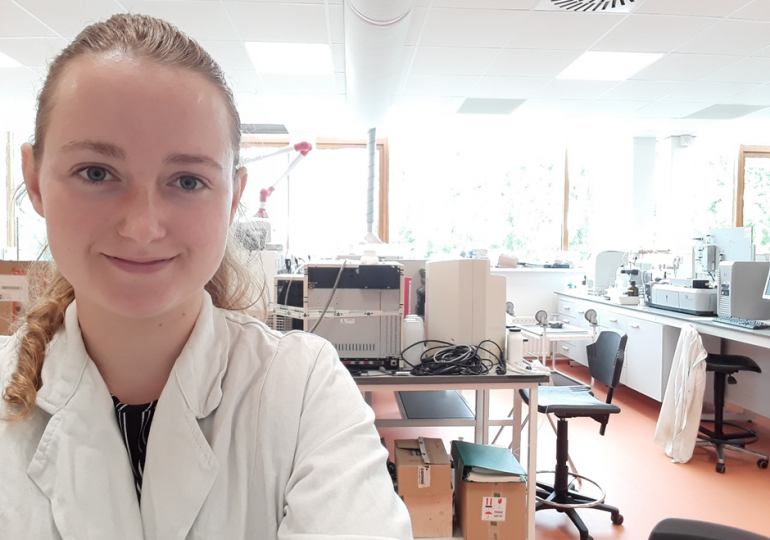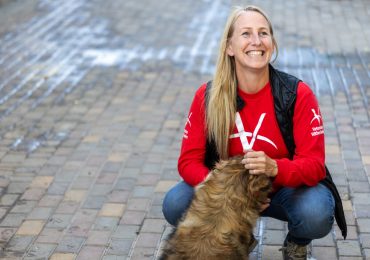Els van de Zande – a post-doc at Wageningen University, the Netherlands – presents her work ‘Enhanced parasitisation of caterpillars and aphids on field-grown Brassica oleracea plants upon soil amendment with insect exuviae’. She discusses how belowground changes can affect aboveground tri-trophic interactions, highlights a silver lining of the Covid-19 lockdowns and makes the case for investing time in volunteer work.
About the paper
Our paper describes a combination of laboratory, greenhouse and field studies aimed at unravelling the effects of changes in the soil caused by amendment with moulted insect skins (exuviae) on the aboveground recruitment of natural enemies of pest insects. For this we sowed Brussels sprout seeds in field soil amended with exuviae originating from three insect species commonly produced for food and feed: black soldier fly larvae, house crickets and yellow mealworms, and later infested the four- or eight-week-old plants with caterpillars or aphids. In the laboratory we measured and identified the volatiles emitted by those plants upon herbivore damage, in the greenhouse we assessed the attraction of the parasitoids Diadegma semiclausum and Diaeretiella rapae towards these volatile blends in an olfactometer, and in the field we studied the proportion of parasitised Plutella xylostella caterpillars and Brevicoryne brassicae aphids for three consecutive years. Our paper shows that amending soil with insect exuviae enhanced the proportion of parasitised individuals of the two herbivore species in the field, and the composition of the plant volatile blend was affected by soil amendment. Furthermore, soil amendment with house cricket or mealworm exuviae resulted in increased attraction of the two parasitoid species in the olfactometer. The increased proportion of parasitised herbivores on plants grown in exuviae-amended soil in the field varied among years, but corresponded to the increased attraction found in the Y-tube olfactometer and changes in plant volatile blends. These results underline the importance of belowground processes, such as the decomposition of insect exuviae, on indirect plant defence and confirms the potential of amending soil with insect residues to promote biological control in sustainable agriculture.
Graphical overview of the main results from the paper
Amending soils with organic substrates has long been common practice in agriculture and has experienced a resurgence of interest in the context of sustainable agriculture. The use of organic amendments can significantly improve soil health, among others by improving soil microbial activity and favouring the growth of beneficial soil microbes such as plant-growth-promoting rhizobacteria. Insect residues originating from the large-scale production of insects for food and feed (frass and exuviae) are a novel type of organic soil amendment that currently gain more and more attention as a growth and yield promotor for a multitude of crop species. However, the effect of amending soil with insect residues on the plants’ interaction with other trophic levels remained elusive. As a first study in this field, we decided to start within the agricultural setting where the soil amendment will be applied and focus on the agricultural relevant natural enemies of insect pest. However, besides this applied perspective, the study is really interesting from a fundamental perspective as well: it adds information needed to fully understand the complex chain of interactions running both ways between the soil amendment, which changes the soil composition à the soil microbiota that will change in composition and activity as well → the plant that will interact with the changed soil microbiota, and is dependent on the soil composition → the pest insect that will respond to the changed nutrient composition and defence level of the plant → the parasitoids that interact with the plant to find its host, and interacts with the herbivores.
About the research
My favourite part of this research was the big puzzle of creating the different methodologies for the laboratory, greenhouse and field study in such a way that it allowed us to properly compare and link result from the separate experiments, while also taking into account the limitations of the different set-ups and keeping the system ecologically relevant. Followed by the fun part: creating figures of the methodology to make it quickly comprehendible for readers of the paper. However, also unforeseen challenges occurred: When the research was well on its way and I was in the middle of the olfactometer assays, together with one of my students, we were not allowed to work in the laboratory or greenhouse anymore due to the Covid-19 lockdown. This meant that we quickly had to asses what would be the best way forward with the limited possibilities of a lockdown. Generalised, it boiled down to two options: either stop the experimental work, finish the analysis of the volatiles at home and publish the results of the first field season, volatile analysis and only half of the intended olfactometer assays, or add another field season – which was the only thing still allowed under the lockdown regulations – and hope that afterwards we could continue with the olfactometer assays. Since I am a big supporter of repeating field measurements over multiple years, I took this opportunity to add another field season to the data set. Unfortunately, this was a really uncommon season, starting with severe drought when the plants were really small, and lots of rain at the moment that I needed the parasitoid wasps to be active. So, in some way I was happy when, after a period of less restrictive Covid-measures in which we could finish the olfactometer assays, another lockdown was enacted and I had a ’good excuse’ to spend the limited time of my PhD on repeating the field experiment for the third year in a row. Also this year the result were less obvious than during the first field season, but that is exactly why I think it is important to repeat these kind of measurements over multiple years (and preferably multiple study sites as well, but that was unfortunately not an option under the Covid-restrictions): If I had only measured the first field season, we would now have thought the insect exuviae to be some kind of miracle soil amendment for biological farming, while when by change I had only measured the second field season, there is a big change that the results would not have been published at all. Taking all the results together is what gives the most realistic representation of the effect of the soil amendment on parasitoid recruitment.
Pictures of the experimental work (from top left to bottom right): Mealworm and its moulted skin (exuvia), MSc student Lina and our first experimental field “the camping” in which all the plants were covered by a mesh tent to prevent early herbivory damage, setting out the grid for our second experimental field right before planting, a dissected caterpillar under the microscope with three parasitoid eggs at the arrow.
The next step in this research is to get an even more realistic idea of the ecological effects of using insect exuviae as a soil amendment in agricultural fields, by monitoring the rhizosphere bacterial community and the aboveground arthropod community development over the course of a full Brussels sprouts growing season (paper currently under review). In contrast to the field experiment in the current paper, in this field experiment we did not manipulate the herbivore population on the plants, which enables us to get a better impression of the final outcome of the interplay between the different interacting organisms as a consequence of the soil amendment. Unfortunately, the time in my PhD was limited, which meant that there was no time to repeat the experiment over multiple years. However, with measuring so many parameters and so much more information that is still to be uncovered, this last part of my PhD research might serve more as an inspiration and invite to other researchers to continue in this line of research, instead of providing clear answers in a complex system.
About the author
I get involved in ecology every once in a while, but I cannot truly call myself an ecologist. If anything, I would be more of an “interactionalist”: Throughout my studies I have focussed on the biotic and abiotic interactions between organisms and organisms and their environment, which comes close to ecology, but also between cells and molecules in the context of organ (plant and animal alike) functioning, and embryo development. When I discovered that with studying plant-insect interactions I could continue working on all these different interactions within one study system, and on multiple levels (molecular, ecological, behavioural etc.), while also producing relevant data for application in for example biological farming, I knew this was the direction I wanted to go. During my PhD research I studied multiple facets of the effects of soil amendment with insect residual streams (exuviae and frass) on the rhizosphere community of Brussels sprout plants, the plant growth and direct and indirect resistance of these plants to belowground and aboveground pest insects. This paper is one of the more ecological studies from my PhD, while I’m also publishing more molecular papers on for example the differences in the activation of plant defence signalling.
Currently, I’m in the submission process for the last chapters of my thesis and work as a post-doc at the Wageningen University Laboratory of Entomology on a related but completely different topic: the role fly larvae can play in the Western food production chain, as poultry feed, for human consumption, and as a recycler of agricultural waste, as well as the ethical, safety and economic aspects involved. Even though I liked venturing into ethical and economic questions, I do start to miss my plant-insect system. So I don’t think it will be long before I’m back at Agroecological research.
For me, there was no clear who or what that inspired me to get in science. However, I do have a great admiration for people that are truly, intrinsically, enthusiastic and passionate about what they do. This was the guy who repaired my bike and could not stop talking about the inner workings of the brakes, the different materials they could use to manufacture it and what the consequences for the user would be. But also the passionate high-school teacher, and my father who would light-up when talking about what he was working on that week. It was those people, and many more, that made me decide to follow what made me truly enthusiastic. However, understanding which part of an activity made me enthusiastic wasn’t always easy (Being outdoors during ecology courses? After weeks of puzzling, finally understanding a new concept? The precise way of working in molecular laboratories? Or connecting the results of different kind of experiments to understand an interaction taking place between organisms?). And over time, I realised this could also change. Especially when I became a mom, I noticed a big shift in how I experienced my PhD research and how the priorities in my life changed. And even though academia is not really designed for parents, especially mothers, I still love being a scientist. I will continue to follow my passion, studying and teaching interactions, but which interactions specifically will most probably change over time.
as a scout leader
To close this blog with one piece of advice for anyone willing to listen: invest time in activities outside your academic bubble. Stepping away from your work every once in a while will give you a mental break and makes it possible to come back to what you were doing with fresh eyes. It creates the opportunity to gain a different perspective, or to rationalise and let go when you were stuck. Furthermore, societies are build upon volunteers: at the local sports club, newspaper, community centre, nature conservation and many other organisations. By helping out at an organisation that fits your passion you can have a direct positive impact on your surroundings, while doing something you like and most probably connect with people that you otherwise never would have met.
Like the blog post? Read the paper here.
Leave a comment





